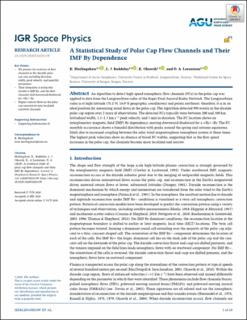A statistical study of polar cap flow channels and their IMF by dependence
Journal article, Peer reviewed
Published version

Åpne
Permanent lenke
https://hdl.handle.net/11250/2756865Utgivelsesdato
2020Metadata
Vis full innførselSamlinger
Originalversjon
Journal of Geophysical Research (JGR): Space Physics. 2020, 125(11), e2020JA028359 10.1029/2020JA028359Sammendrag
An algorithm to detect high-speed ionospheric flow channels (FCs) in the polar cap was applied to data from the Longyearbyen radar of the Super Dual Auroral Radar Network. The Longyearbyen radar is at high latitude (78.2°N, 16.0°E geographic coordinates) and points northeast; therefore, it is in an ideal position for measuring zonal flows in the polar cap. The algorithm detected 998 events in the dayside polar cap region over 2 years of observations. The detected FCs typically were between 200 and 300 km latitudinal width, 1.1–1.3 km s−1 peak velocity, and 3 min in duration. The FC location shows an interplanetary magnetic field (IMF) By dependency, moving dawnward/duskward for a +By/−By. The FC monthly occurrence shows a bimodal distribution with peaks around the spring and autumn equinoxes, likely due to increased coupling between the solar wind-magnetosphere-ionosphere system at these times. The highest peak velocities show an absence of broad FC widths, suggesting that as the flow speed increases in the polar cap, the channels become more localized and narrow.
